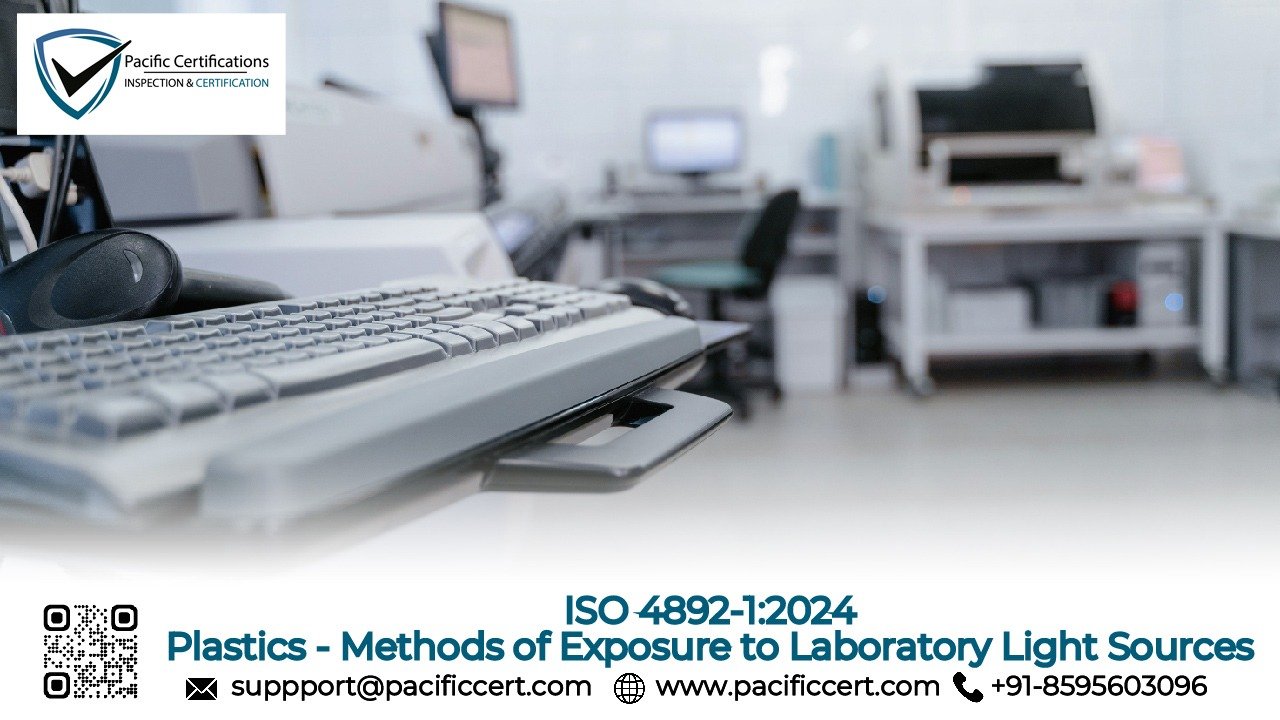ISO 4892-1:2024 Plastics — Methods of Exposure to Laboratory Light Sources

What is ISO 4892-1:2024 Plastics?
ISO 4892-1:2024 defines the general principles for exposing plastic specimens to laboratory light sources in order to simulate real-world conditions and assess material performance over time. It serves as Part 1 in a multi-part standard covering various types of light sources, including xenon arc, fluorescent UV, and carbon-arc lamps.
This updated version of the standard, published in 2024, reflects the latest technological advances in exposure testing and incorporates refinements in testing methodologies, improving consistency and reproducibility across laboratories worldwide.
Key components of the standard include:
- General guidelines for specimen preparation
- Apparatus specifications
- Environmental conditions (temperature, humidity, irradiance)
- Monitoring and calibration requirements
- Reporting formats and interpretation of results
Requirements of ISO 4892-1:2024
To comply with ISO 4892-1:2024, an organization must follow detailed procedural steps for testing and documenting the exposure of plastic materials. Below are the main requirements outlined in the standard:
Exposure Conditions
- Specify type and intensity of light source
- Maintain consistent irradiance, typically 0.35–0.50 W/m² at 340 nm for UV sources
- Control temperature and humidity inside the chamber
- Rotate or reposition samples to ensure uniform exposure
Specimen Preparation
- Use standardized dimensions and surface finishes
- Clean and condition samples before exposure
- Ensure that no prior degradation has occurred before the test
Apparatus Calibration
- Instruments must be regularly calibrated using reference standards
- Sensors for irradiance, temperature, and humidity must meet precision criteria
- Filter systems must replicate daylight, window-glass, or artificial lighting conditions
Exposure Durations
- Vary depending on material type and intended end-use
- Often involve cycle testing (e.g., 8 hours light, 4 hours dark with condensation)
Data Recording & Reporting
- Log all environmental parameters, equipment settings, and deviations
- Provide clear and traceable documentation of test conditions and sample changes
Post-Exposure Evaluation
- Assess changes in color, gloss, tensile strength, elongation, and impact resistance
- Use comparative analysis with control specimens
How Pacific Certifications Can Help with ISO 4892-1:2024
As an accredited third-party certification body, we at Pacific Certifications offer full-spectrum support throughout the certification journey for ISO 4892-1:2024:
Gap Analysis & Consultation
We begin by conducting an initial review of your organization’s current processes, lab setups, and testing methods. This helps to identify gaps against ISO 4892-1:2024 requirements.
Technical Training & Documentation Support
Our experts offer onsite and virtual training to equip your team with the necessary knowledge. We also help create and refine your documentation — from test protocols to calibration records.
Laboratory Audit & Compliance Verification
We perform comprehensive audits of your test facilities, equipment calibration logs, and procedural adherence. This ensures that your practices align with the standard’s specifications.
Issuance of ISO 4892-1:2024 Certification
Upon successful completion of the audit and compliance verification, we issue a globally recognized ISO 4892-1:2024 certificate, boosting your market credibility.
Ongoing Surveillance & Recertification
We also offer annual surveillance audits and timely recertification services to ensure your continued compliance and process improvement.
Benefits of ISO 4892-1:2024
Achieving compliance with ISO 4892-1:2024 opens a wide array of advantages for plastic manufacturers, laboratories, and end-users alike.
Product Durability
Simulated exposure testing helps anticipate material failures, allowing manufacturers to enhance UV resistance and longevity.
Global Practices
This standard ensures uniform testing criteria, enabling cross-border comparisons and facilitating international trade.
Customer Confidence
Certified products signal commitment to quality, reassuring customers of the product’s reliability in real-world conditions.
Competitive Advantage
Certification demonstrates a proactive quality assurance approach, providing an edge in regulatory approvals, tenders, and OEM partnerships.
Field Failures and Warranty Claims
Early detection of weak formulations or materials can minimize costly recalls and warranty servicing.
Who Needs ISO 4892-1:2024?
ISO 4892-1:2024 is applicable to a wide range of sectors where plastics are exposed to sunlight or artificial lighting, such as:
Plastic Manufacturers
Those producing outdoor products, automotive parts, or packaging must ensure their materials withstand prolonged exposure.
Testing Laboratories
Accredited labs offering weathering or photostability testing services need ISO 4892-1:2024 compliance for method validation.
R&D Departments
Material scientists and engineers use this standard to benchmark formulations and improve product designs.
Regulatory Bodies and OEMs
Governments and original equipment manufacturers often require proof of compliance with ISO 4892-1:2024 for product approval.
Construction and Architecture Firms
PVC windows, roofing membranes, and insulation systems often undergo accelerated light exposure tests for validation.
The ISO 4892-1 standard is a cornerstone in material durability assessment, especially for applications involving exposure to light. By adhering to this standard, organizations demonstrate not only technical competence but also a commitment to quality and innovation.
At Pacific Certifications, we are proud to support companies on their path to ISO 4892-1 compliance. From initial consultation to final certification, our experienced auditors ensure you meet every requirement with precision and confidence. Get in touch with us today to discuss how we can add value to your quality assurance strategy!
Pacific Certifications is accredited by ABIS, in case you need support with ISO 4892-1 certification for your business, please contact us at suppport@pacificcert.com or +91-8595603096
FAQs
What is the purpose of ISO 4892-1:2024?
It defines procedures for simulating sunlight and other light exposures in a laboratory setting to evaluate plastic material performance.
How does ISO 4892-1:2024 differ from previous versions?
The 2024 revision incorporates updated apparatus calibration guidelines, better environmental controls, and enhanced result interpretation protocols.
Is ISO 4892-1:2024 certification mandatory?
While not legally required, certification significantly boosts market acceptance and product reliability assurance.
How long is the ISO 4892-1:2024 certification valid?
Generally, certification is valid for three years, with annual surveillance audits to maintain validity.
Can Pacific Certifications help with ISO 17025 compliance as well?
Yes, we also provide ISO/IEC 17025 audit and certification services for testing and calibration laboratories.
What kind of industries benefit from ISO 4892-1:2024 certification?
Industries like automotive, construction, aerospace, consumer goods, and electronics benefit greatly from this certification.
Read more : Pacific Blogs

